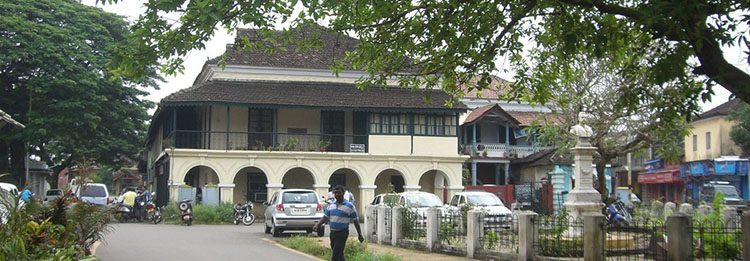A short distance away from the busy crowded Panjim bus stop is an area where time seems to have stopped. The area is called São Tomé/Fontainhas. This is the oldest Latin quarter of Panjim, It has the aura of a Mediterranean city. It is located at the foot of the hills and gets its name from the Portuguese word for “little fountain” because there are freshwater springs on the west side near the Altinho hills. On the east side, it is bounded by an ancient creek known as the Ourem creek.
The Mint and the Surgeon General of Goa
Did you know what the chief item of trade by the Portuguese in Goa was? Contrary to popular belief, it was not spice. Though spice was an important item of trade by Vasco de Gama and the settlements in Cochin; in Goa, the chief item of trade was the Arabian thoroughbred horses. There were sired in Portugal and brought here to Goa to be sold to the different rulers of the princely states of India. AT the banks of the Mondovi river there still lies the home of a Flemish horse trader. The house is named Casa de Moeda. In Portuguese, it means ‘house of coins’. It served as the Mint. It is flanked by the Mandovi River on one side and the red and white buildings of the post office of the other side.
According to various historical texts, the Viceroy of Goa, Dom Manuel de Portugal e Castro, was unhappy with the coins minted in Velha Goa. So he ordered that the mint be shifted to Panjim in Nova Goa. The new Nova Goa mint functioned from 1845-1869.
After being used as a mint, the building was owned variously by individuals, the public exchequer, and even housed the telegraph offices of the British and the Portuguese before it was purchased by General Dr Miguel Caetano Dias (in 1904), He served as the Surgeon General of Goa and initiated the setting up the Goa Medical College (not the modern one at Bambolim but the older one in Panjim). His descendants still live in Casa de Moeda. This building may be one of the few buildings in India that was occupied by both the Portuguese and the British governments.
Al the other end of the road from Casa de Moeda is the old Adil Shah Palace. It served as the state secretariat building It is now the State Archaeology Museum. It serves as another piece of beautiful heritage architecture in Panjim.
But let’s get back to the São Tomé/Fontainhas heritage area.
Old Patto Bridge
A short distance from Casa de Moeda is a small old bridge. It’s called the Ponte Conde de Linhares or the Old Patto Bridge. It marks the start of the causeway to Ribandar. This causeway was built by the Jesuits so that they could have easy access to the Cathedral at Old Goa and the city of Velha Goa.

Capela do São Tomé (Chapel of St. Thomas)
On the right side of the General Post-office, you’ll find the age-old chapel of Saint Thomas who was an apostle of Jesus. His tomb lies in Chennai. Perhaps this chapel is a fallback to the days when Vasco de Gama landed in Cochin and got influenced by the Christian followers of St Thomas there.
Capela do São Sebastião (St. Sebastian’s Chapel) in Fontainhas
Speaking of Chapels, there’s another famous Chapel in the Fontainhas heritage area. It’s called the Capela do São Sebastião or St. Sebastian’s Chapel. An important feature of this Chapel is the crucifix that was brought here when St. Francis requested the Portuguese monarch to start an inquisition in Goa too. This is an unusual crucifix because unlike most others, the image of Christ, here, has his eyes open, not closed. Many Goan Catholics today still worship at this chapel and pray before this crucifix.

Not far from the Chapel of St Sebastian is The Fundacão Orienté – a Portuguese public organization involved in the task of restoration of heritage buildings in Goa. It is located in an old Portuguese house that has been renovated.
In fact, every year, for one week, the historic houses in Fontainhas are turned into art galleries, with residents displaying their artworks, unique architectural features of their balconies, and furnishings in their dining halls.
Hindus lived here too
Were there only Christians living in this area? No, there are quite a few houses of the Hindus too. Though their architectural styles are a bit different. Here’s a two-storied Hindu house that is rather well-kept and serves as a reminder of the communal harmony. These Hindu houses are also often turned into art galleries.

The beauty of the Fontainhas area is timeless. Here, time seems to have stood still. The quaint old houses with white coral shell windows, huge arches, grand balconies, rooftops with roosters on them (there’s a legend about those roosters- it seems a man who was being sent to the gallows pleaded innocent and said that if he is sent to the gallows, the rooster will crow to prove his innocence. It did, and so he was saved, and so till today, folks here have clay roosters on their roofs.
Did I mention that the famous architect Charles Correa lived in this area? This is one of the well-kept houses. It’s painted white unlike most of the other houses that are painted in bright colours.

If you get an evening off, do take a heritage walk down the São Tomé/Fontainhas area. You’ll see a Goa that dates back almost 400 years and enjoy the age-old beauty that seems to be so well preserved, even today.


